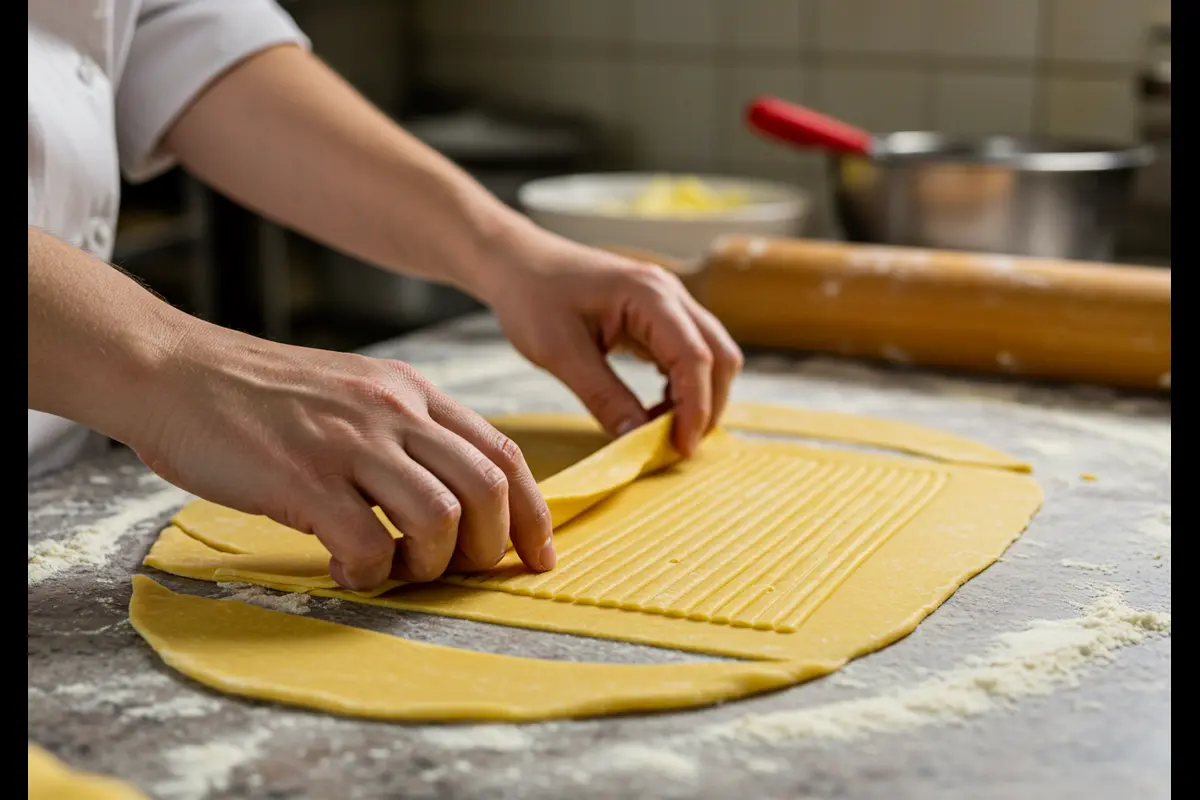Introduction
Croissants—light, flaky, and buttery—are the perfect pastry to elevate any breakfast or brunch. This guide will show you how to make homemade croissants with an easy-to-follow recipe that eliminates the complexity of traditional methods while delivering all the deliciousness. Whether you’re a beginner or an experienced baker, you’ll find valuable tips, tricks, and insights here to ensure your croissants come out perfectly every time. We’ll cover everything from ingredients and dough preparation to baking and creative variations. Let’s get started on this easy croissant recipe that’s bound to impress!
Introduction to Easy Croissant Recipe
What Is a Croissant?
A croissant is a classic French pastry with a crescent shape, loved worldwide for its light, airy texture and buttery flavor. Croissants fall under the category of laminated pastries, meaning the dough is folded repeatedly with layers of cold butter to create those iconic flaky layers. While traditional croissants might seem complicated, our easy croissant recipe simplifies the process without compromising on taste or texture.
Why Make Croissants at Home?
There’s nothing quite like the smell of freshly baked croissants wafting through your kitchen. Store-bought croissants can’t compete with the flavor and freshness of homemade ones. By baking your own, you can:
- Control the ingredients for a healthier, more natural result.
- Experiment with unique fillings like chocolate, almond, or savory options.
- Enjoy the pride and satisfaction of mastering this bakery favorite.
Overview of Laminated Dough Techniques

Laminated doughs like croissant dough rely on layering butter between thin sheets of dough. When baked, the butter creates steam, causing the layers to puff up beautifully. This process results in the flaky, tender texture croissants are famous for. While traditional methods involve precise folding and a “butter square,” this easy croissant recipe uses a streamlined approach that saves time and effort while delivering comparable results.
Stay tuned as we dive deeper into the ingredients and tools you’ll need to start your croissant-making journey!
Ingredients and Tools for Easy Croissant Recipe
Key Ingredients for Croissants
Crafting the perfect easy croissant recipe begins with choosing the right ingredients. Here’s what you’ll need:
- Flour: All-purpose flour works best, providing structure to the dough. For softer results, consider experimenting with bread flour.
- Butter: High-quality, unsalted butter is a must! Its flavor makes all the difference, and it’s essential to keep it cold throughout the process.
- Sugar: A touch of sugar adds a subtle sweetness and aids in the browning process during baking.
- Yeast: Active dry yeast helps the dough rise. You can substitute it with instant yeast, but make sure to follow specific instructions for activation.
- Milk: Whole milk adds richness to the dough, but plant-based options can be used for a vegan twist.
- Salt: A pinch of salt amplifies the buttery flavor, balancing the sweetness perfectly.
Essential Tools
To make croissants at home, having the right tools ensures a smoother baking experience:
- Rolling Pin: A sturdy rolling pin is necessary for laminating the dough and creating those flaky layers.
- Parchment Paper: Prevents sticking and makes handling the dough easier.
- Sharp Knife or Pizza Cutter: For cutting the dough into precise triangles.
- Mixing Bowls: Choose a large bowl for mixing the dough and smaller ones for prepping other ingredients.
Using high-quality ingredients and tools ensures that your easy croissant recipe turns out just as impressive as bakery-bought ones. For tips on perfecting other baked treats, check out this guide on churro cake recipes.
Preparing the Dough – A Simple Approach
Mixing the Ingredients
Start by combining the dry ingredients—flour, sugar, salt, and yeast—in a large mixing bowl. Gradually add cold butter, cut into thin slices, ensuring each piece is coated in the flour mixture. Next, pour in cold milk and stir using a spatula until the dough comes together into a firm, cohesive ball. This step is crucial for achieving a smooth texture and creating a dough that’s easy to handle.
Chilling the Dough
Once the dough is formed, wrap it tightly in plastic wrap and refrigerate it for at least an hour. This resting period:
- Allows the gluten to relax, making it easier to roll.
- Ensures the butter stays firm, which is vital for creating flaky layers.
Pro Tip: If the dough becomes too soft at any point, chill it again before proceeding to the next step. Chilled dough is much easier to work with and ensures professional-quality results.
Now that your dough is prepped and chilled, it’s time to dive into laminating and shaping in the next steps!
Laminating the Dough – Creating Flaky Layers
What Is Laminating?
Laminating is the magic behind a croissant’s light, flaky texture. It involves folding and rolling butter into the dough multiple times to create thin, alternating layers of dough and butter. When baked, the butter melts and releases steam, causing the layers to puff up and become irresistibly airy. This is the secret to achieving bakery-quality croissants with this easy croissant recipe.
Rolling and Folding Steps
- Roll the Dough into a Rectangle: Begin by lightly flouring your surface. Roll the chilled dough into a rectangle, roughly 10 inches wide and 22 inches long.
- Fold into Thirds: Imagine folding a letter—bring one end of the dough into the center, then fold the other end over it. This creates the first set of layers.
- Chill Between Folds: Wrap the dough in plastic and chill for 30 minutes after every fold to keep the butter cold. Repeat the rolling and folding process 4-6 times, turning the dough 90 degrees each time.
- Look for Streaks of Butter: As you laminate, you’ll notice streaks of butter creating those signature layers. If the butter feels soft, chill the dough again before continuing.
How to Know When the Dough Is Ready
The dough should feel smooth and pliable, with visible streaks of butter throughout. Don’t overwork the dough, as the layers might blend together, reducing the flakiness. At this stage, your dough is perfectly laminated and ready for shaping!
Shaping and Proofing Croissants
Cutting the Dough into Triangles
Once the laminated dough is ready, divide it into two manageable pieces. Roll each piece into a rectangle about 1/8-inch thick, 10 inches wide, and 22 inches long. Use a sharp knife or pizza cutter to trim uneven edges, then cut the dough into long, skinny triangles. Aim for triangles with a 5-inch base for uniformity.
Rolling into Crescent Shapes
- Notch the Wide End: Make a small cut in the center of the wide end of each triangle. This helps the dough curve into a crescent shape.
- Roll Tight Crescents: Starting at the wide end, roll the dough tightly toward the tip, tucking it underneath the croissant. Gently curve the ends to form the classic crescent shape.
- Place on Baking Trays: Arrange the shaped croissants on a parchment-lined baking sheet, leaving enough space for them to rise and expand.
Proofing for Light, Airy Results
Proofing is the final step before baking and is essential for achieving the soft, airy texture of croissants. Cover the shaped croissants lightly with greased plastic wrap and let them rise in a warm place for 1-2 hours until they’ve doubled in size.
Pro Tip: To break up the process, you can refrigerate the shaped croissants overnight and proof them in the morning before baking. This is a great option if you want fresh croissants for breakfast.
For more delicious pastry recipes, you might enjoy this guide to making churro cakes on the Grate Recipes website.
Next, we’ll explore baking tips and creative variations to make your croissants truly unique!
Baking Perfect Croissants

Setting the Oven Temperature
The final step in bringing your easy croissant recipe to life is baking. Start by preheating your oven to 375°F (190°C). A hot, even oven is essential to create the steam needed for puffing up those flaky layers. Don’t skip this step—preheating ensures consistent results and beautifully golden croissants.
Applying Egg Wash for a Golden Finish
Before baking, lightly brush the proofed croissants with an egg wash. Simply beat one large egg with a teaspoon of water to achieve a smooth consistency. The egg wash does more than add a glossy sheen—it helps the croissants bake evenly and develop that irresistible golden-brown color.
Baking and Cooling
Place the croissants in the preheated oven and bake for 15-20 minutes. Watch as they rise and transform into beautifully flaky pastries with perfectly crisp edges. Once baked, transfer the croissants to a wire rack to cool slightly before serving. Warm croissants fresh from the oven are undeniably the best!
By now, your kitchen should smell like a Parisian bakery, and your croissants will rival those from the finest patisseries.
Variations and Creative Twists
Stuffed Croissant Variations
One of the best parts about mastering this easy croissant recipe is the ability to get creative with fillings. Here are a few ideas to take your croissants to the next level:
- Chocolate Croissants: Place a small piece of dark chocolate on the wide end of each triangle before rolling.
- Almond Croissants: Add a layer of almond paste or frangipane before shaping, and sprinkle sliced almonds on top before baking.
- Savory Croissants: Fill with ham and cheese or even sautéed spinach and feta for a delightful savory twist.
Making Vegan Croissants
If you’re looking to adapt this recipe, vegan croissants are entirely possible. Replace butter with a high-quality plant-based alternative and use almond or soy milk instead of dairy. The laminating process remains the same, and the result is just as flaky and delicious.
Experimenting with fillings and variations is a fun way to make this recipe your own. Whether sweet or savory, croissants are endlessly versatile and always a crowd-pleaser!
Serving and Storing Croissants
How to Serve Croissants
Freshly baked croissants are a treat all on their own, but they can be dressed up in countless ways. Serve them warm with a simple pat of butter or a dollop of jam for a classic breakfast. For something sweeter, try pairing them with honey, chocolate spread, or fruit preserves.
If you prefer savory options, croissants make an excellent base for sandwiches. Split them in half and fill them with chicken salad, scrambled eggs, or smoked salmon. Whether you’re hosting a brunch or enjoying a quiet morning, this easy croissant recipe is versatile enough to suit any occasion.
Storage Tips
To keep your croissants fresh, store them in an airtight container at room temperature for up to two days. For longer storage, refrigerate them for up to a week, although reheating them before serving is recommended to restore their crisp texture.
Want to save them for later? Croissants freeze beautifully! Wrap them individually in plastic wrap and place them in a freezer bag. To enjoy, thaw at room temperature and reheat in the oven for 5-10 minutes at 350°F (175°C). Freezing ensures your hard work in perfecting this easy croissant recipe doesn’t go to waste!
Troubleshooting Common Issues
Why Did My Croissants Not Rise?
One common challenge when making croissants is a lack of rise. This could happen if your yeast was expired or improperly activated. Be sure to check your yeast’s freshness and proof it correctly if the recipe calls for it. Additionally, croissants need a warm environment to proof properly. If your kitchen is cold, consider proofing them in an oven with the light on to maintain consistent warmth.
How to Avoid Butter Leakage
Butter leakage can be frustrating but is often caused by soft butter or overworked dough. To prevent this:
- Keep the butter cold during every stage of the process.
- Chill the dough frequently, especially after laminating and before shaping.
- Avoid rolling the dough too thin, as it can weaken the layers and cause the butter to escape during baking.
With a bit of practice and these tips, your easy croissant recipe will come out perfectly every time. Remember, even professional bakers face challenges when making croissants, so don’t be discouraged by initial hiccups—just enjoy the process and keep baking!
Troubleshooting Common Issues
Why Did My Croissants Not Rise?
If your croissants didn’t rise as expected, don’t worry—this is a common issue. The most likely culprit is inactive yeast. Always check the expiration date on your yeast, and proof it in warm milk (around 110°F or 43°C) to ensure it activates properly.
Another possible issue is the proofing environment. Croissants require a warm, draft-free space to rise. If your kitchen is too cold, place the shaped croissants in an oven with the light on or near a warm spot like the stovetop. Be patient; rushing this step can lead to dense results.
How to Avoid Butter Leakage
Butter leakage can happen if the dough or butter isn’t cold enough. To prevent this, make sure your butter is firm but pliable before laminating the dough. Always chill the dough after every fold and before cutting it into triangles.
Overhandling the dough can also cause the butter to break through the layers. Be gentle during the rolling process and use just enough flour to prevent sticking without drying out the dough. Following these steps will help you nail this easy croissant recipe without any buttery mishaps!
FAQs For Easy Croissant Recipe
Can I Make Croissants Without Yeast?
Traditional croissants rely on yeast to achieve their fluffy, airy texture. While it’s possible to make a similar pastry using baking powder or soda, the results won’t have the same layers or flavor. If yeast intimidates you, try practicing with simpler bread recipes before tackling croissants.
How Long Does the Process Take?
Making croissants is a labor of love! From start to finish, this easy croissant recipe takes about 8-12 hours, including resting and proofing times. However, breaking the steps into two days (making the dough on the first day and baking on the second) can make it more manageable.
Can I Freeze the Dough?
Absolutely! After laminating the dough, you can freeze it tightly wrapped for up to two weeks. Thaw it overnight in the fridge before rolling, cutting, and shaping the croissants. This method saves time while still delivering fresh, homemade pastries.
What Is the Difference Between Croissants and Danish Pastry?
Though both are laminated pastries, the main difference lies in the ingredients. Danish pastry dough typically contains eggs and is slightly sweeter, while croissant dough uses milk and is less sweet. Both are delicious, but croissants are known for their light, flaky texture, perfect for this easy croissant recipe.
By now, you have all the knowledge needed to master croissants at home. Whether you’re savoring a plain one or experimenting with fillings, your homemade croissants will surely impress!
Conclusion ( Easy Croissant Recipe )
Mastering the art of making croissants at home may seem like a challenge, but with this easy croissant recipe, the process becomes approachable and rewarding. From laminating the dough to shaping those iconic crescent layers, every step is an opportunity to create something truly special. Whether you enjoy them plain, stuffed with chocolate, or filled with savory ingredients, homemade croissants bring unmatched freshness and flavor to your table.
So, gather your ingredients, roll up your sleeves, and give this recipe a try. With patience, practice, and a little creativity, you’ll soon be baking croissants that rival even the best bakeries. Happy baking!

